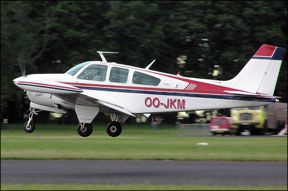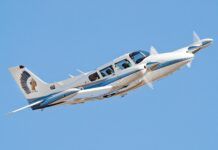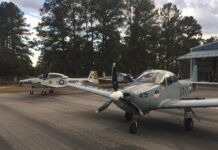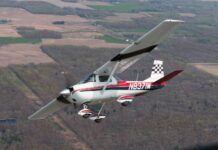Beechcraft’s Model 33 Bonanza was one of the few piston singles to survive the great general aviation slump of the 1980s. The quintessential doctor/lawyer single, it even outlived the previous archetype, the Model 35 V-tail Bonanza, by 12 years, only succumbing even as the landmark product-liability-reforming General Aviation Revitalization Act of 1994 became law. Ultimately, the six-seat Model 36 proved more popular than the four/five seat 33s. Since both reportedly cost about the same to manufacture, its a wonder the 33 held on as long as it did.
But the four-seat, straight-tail Bo remains popular today. Owners love its flying qualities, performance, cabin comfort and sturdy construction. While many pilots, however, have words on the high cost of parts and maintenance supposedly typical of Beech aircraft, owners generally report a well-cared-for example needs very little. There are a few things to be careful of when operating a Bonanza, whether a 33 or V-tailed 35.
History
Beech essentially invented the modern, high-performance, retractable single just after WWII, when it introduced 1947s original Bonanza. At the time, there was little competition: Cessnas lineup consisted of airplanes like the 120, 140 and 170, while Piper was building even simpler tube-and-fabric airplanes like the Cub and Super Cruiser. North American Aviations all-metal Navion used the same engine, but flew more slowly. Along came the Bonanza and, suddenly, almost anyone could afford to fly at DC-3 speeds.
By the late 1950s, the Bonanza was facing real competition, though. Airplanes like Pipers Comanche 250 offered comparable performance and styling for about two-thirds the price. Cessnas 210 wouldn’t emerge until the same year as the first Model 33, but there’s no doubt Beech knew what was going on at its Wichita neighbor. By this time the Bonanza had built up a powerful brand image and the company did not want to hurt sales of its flagship single by competing on price.
Instead, the company responded by introducing a new airplane to compete against the Comanche and 210 while retaining the V-tailed Bonanza for those who still wanted the “real thing.” And Beech charged them accordingly. Meanwhile, the new model was clearly a Bonanza, even if the nameplate said “Debonair.” In fact, Debonairs carry a formal model number beginning with “35.” From the spinner back to a certain bulkhead, it was the same basic airplane. Aft of that bulkhead, however, and instead of the trademark tail, the new Model 33 sported a conventional, three-surface tail, looking a lot like the Comanches.
Other changes abounded: The Bonanzas 250-HP Continental IO-470-C was replaced by a 225-HP IO-470-J. Gross weight was somewhat less. Beech also removed much of the equipment that came with a typical Bonanza: things like paint, vertical speed and turn-and-bank indicators and sun visors. The result was a rather Spartan airplane in stock trim, but one priced competitively. It wasn’t a terribly new strategy, but it has been used repeatedly through the years to boost sales and limit sticker shock. Mooney did it in the early 1980s with the 201 “Lean Machine,” and Piper followed suit a few years later with the Cadet.
Despite aggressive pricing, the Debonair didn’t take the market by storm. Some 233
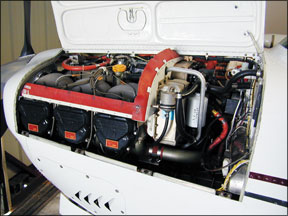
288
were built the first year, compared to over 800 Comanche 250s and 400 35 Bonanzas. Still, the airplane proved popular enough for Beech to continue with it and changes were made almost immediately. The A33 1961 came with extra windows, a hat shelf and a boost in gross weight, from 2900 to 3000 pounds-still less than the Bonanza-and the same 225-HP engine. Production amounted to 154. The B33 followed in 1962, with a new, standard-T panel and a different variant of the Continental IO-470, the K. It remained in production through 1964, with 426 copies made.
The C33 in 1965 got another boost in gross weight, but this was more than offset by an increase in empty weight. There were several other minor improvements as well. For example, the earlier Debonairs had a bench rear seat. This was replaced by individual seats, and a practically useless fifth seat was offered as an option. Larger rear windows were made available, and the hat shelf was enlarged. By this time, all fuel was carried in leading-edge rubber bladders. Standard capacity was 50 gallons; 80 gallons was optional. The C33 remained in production through 1967. 306 were built.
But in 1966, Beech also brought out the precursor to what the Model 33 would become: the C33A. The big news here was the engine: The C33A was fitted with the V35 Bonanzas 285 HP Continental IO-520-B/BA, making it for all intents and purposes a straight-tailed Bonanza (although Bonanza purists maintain a “straight-tail” Bonanza is one of the early V-tail models, with narrow-chord ruddervators). Gross weight increased to 3300 pounds, 100 pounds shy of the same-year Bonanza. The only real changes to previous Debonair airframes involved adding cowl flaps for extra cooling, installing a different nosebug and canting the engine slightly down and right, same as was done on the S35 and subsequent V-tails equipped at the factory with an IO-520. The C33A was built for two years, 1966 and 1967, with a total production run of 179.
Things started to get even more interesting at Beech in 1968. The six-place Model 36 Bonanza was introduced, and the company made official what everybody already knew: The Debonair was really just a Bonanza with a different tail and less elaborate equipment. The 1968 Model 33 was the E33 Bonanza, and the company continued producing the 225 HP versions as well as the 285 HP E33A model. The only real difference, other than the name change, was a new windshield. There were 116 E33s produced and 85 E33As. For some reason there was no D33.
Of particular note was another 33 variant produced during this time, the E33C, which has the distinction of being certified for aerobatics. Major differences between the -C and the -A are a strengthened tail, positive-pressure fuel pump and a cabin door that can be jettisoned. Those wanting one will have to look hard, because aerobatic Bonanzas are rather rare. Total production of the E33C for the two years they were made amounted to 25. There was also an F33C, beginning in 1970, with total production of 154 aircraft before the model was terminated in 1987. These airplanes command a hefty premium on the used marketplace. Expect to pay at least an extra $25,000, all else being equal, for the privilege of flying beyond the limits of the utility category.
The F33, last of the 225 HP Bonanza 33s, was introduced in 1970 and lasted only a year, with 20 built. It differed by having larger rear windows and more baggage space. Its sibling, the 285 HP F33A, continued in production through 1994. There was one last variant, the G33, built in 1972 and 1973, with a total production run of 49. It had a 260 HP Continental IO-470-N.
Things settled down after the F33As introduction, and other than improving the avionics suite, Beech left well enough alone. Good thing, too: the F33A is a fine aircraft, and nearly 1800 were built before production stopped. The price, of
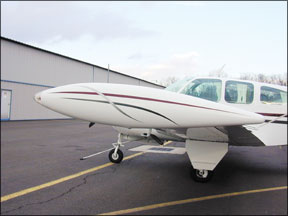
288
course, climbed steadily. In 1970, a new, average equipped F33A could be had for a tick under $50,000. By the mid-90s, a new one would set you back over $325,000.
Which Bonanza?
The original Debonair was definitely a downmarket airplane compared to the 35 Bonanza. Over the years, though, the Debonair was given ever more lavish equipment and more power, and it evolved to its rightful spot in the Bonanza lineup. Still, for a long time there was a perception that the V-tail was better, and it carried a premium. That is no longer true.
For example, a 1970 V35B sold new with average equipment for a little over $54,000, while the F33A (same engine and airframe, different tail) went for about 10 percent less. Those same two airplanes have now reversed roles. The 1970 V35Bs average retail is $7000 less than the same-year F33A.
The Model 33s success is due in no small part to the 35 Bonanzas in-flight breakup problems, which dogged the V-tail through the early 1980s and at least helped end its production. There was an AD to strengthen the tail, and it worked well; nevertheless, the V-tails reputation was damaged and it was pulled from production.
Looking again at the competition, the Bonanza generally has held its value better, although its advantage is slipping in todays economy, along with other types. The 1970 Piper Comanche 260 brings about $12,000 less than a 1970 F33A and is on par with the less-powerful 225 HP F33. This ranking hasn’t changed much in the years we’ve been looking at the various models.
Performance and Handling
This is where Bonanzas really shine. They have some of the best-harmonized controls in the business. Pilots love the handling, but are also quick to point out its important to stay ahead of the airplane, particularly in IMC. Unfortunately, staid, solid handling typically translates into good suitability as an instrument platform. That’s not to say the Bonanza isn’t a good instrument airplane. It is. But it isn’t a “trim it and forget it” airplane, and we would consider an autopilot mandatory for any serious IFR work in it.
Typical of single-engine retracts with high wing loading, the stalls are sharp but not that difficult to recover with proper technique. Landings are easy, provided the pilot watches power settings and airspeed closely.
The 33 is fast enough to make it one of the better piston singles for cross-country work. Pilots of the 225 HP airplanes typically flight plan for 150 knots and 12 GPH. The more powerful 33s are faster, of course, but use more fuel. Figure 165-172 knots on 13-15 GPH for a 285 HP model. Climb performance also is relatively good.
The airplanes are rather slippery; lower the nose, and they’ll pick up speed quite readily. Early Debonairs have a relatively low maximum gear speed: 122 KIAS. However, an increase to 143 KIAS on the B33 and later models helps a lot. Maximum flap speed is a low 104 KIAS on early Debonairs, but it was raised to 113 KIAS on the C33 and to 123 on the F33A. Flap levers in airplanes built in 1979 and later have a detent for an “approach” setting (15 degrees) that can be selected up to 154 KIAS.
Comfort and loading
The 33s cabin is quite comfortable, with appointments of typically high Beech quality. Large windows help, both with visibility and the perception of spaciousness, if not its reality. Rear-seat passengers in the 33 often complain about the airplanes tendency to Dutch roll in turbulence, and many pilots have had yaw dampers fitted, but few complain about legroom. Some pilots say there’s no problem with Dutch roll, and there’s no doubt the 35 is more prone to tail-wagging than the 33.
One characteristic of the 33 (and 35) Bonanzas is the CG will shift aft as fuel is burned. Its important to do a weight and balance calculation for both ends of the flight. The airplane does not like aft CGs, which is easy to do in the 33/35 models, where it becomes overly sensitive in pitch.
The cockpit is well laid out, though it does have quirks. Visibility is quite good. The Beech control yoke arrangement blocks part of the panel when on the ground, but for the most part it shows good design. Once airborne, and the control column-whether dual-yoke or throw-over single-yoke-is in a neutral position, view of and access to the lower panel is improved.
Systems
Overall, Bonanzas have robust, well-designed systems. The gear, for example, is a sturdy electro-mechanical design that is very strong and far less prone to trouble than some other types. Flaps are electric, while flight controls use traditional cables and pulleys.
There are some oddities, though. When Beech was deciding where to place the controls in the cockpit all those decades ago, it put things “backward” relative to
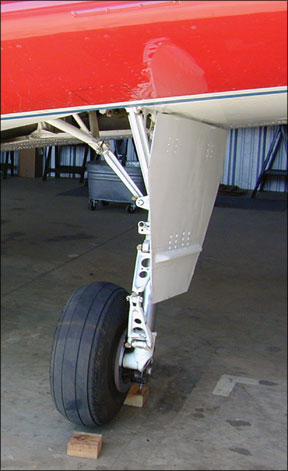
288
most airplanes today. In particular, the designers put the gear control to the right of the engine controls, and the flap switch to the left. There’s nothing wrong with this arrangement, and Bonanza purists argue-tongue only slightly in cheek-that other manufacturers got it wrong, not Beech. Ultimately, though, most everyone else did it the other way around. Of course, this has led to more than one gear-up incident. Beech eventually switched the locations, but in a classic example of Murphy’s Law the now-“standard” location caused confusion amongst Beech pilots who’d gotten used to the old style controls. The pilot must pay attention, particularly when transitioning from one airplane to another. Beech did offer an optional automatic gear-extension system, called “Magic Hand,” which works in a fashion similar to the Piper Arrows. It is sometimes troublesome to rig, though, and its not a common option. Owners flying airplanes with the system generally leave it turned off.
Early models had an odd fuel system, too. When the optional extended-range tanks are installed, excess fuel drawn from the auxiliaries is returned…but always into the left main tank. If there isn’t enough room, its vented overboard. So, its important to run the left main down before switching to the auxiliaries. Older 33s also had fuel gauging that would read only one tank at a time.
Later models inherited the 35 Bonanzas fuel system, which has none of these foibles.
Maintenance
Over the years, Bonanzas have earned a reputation for being expensive to own and operate. Parts prices, especially, often have been labeled exorbitant. In reality, though, many owners stress the importance of finding a mechanic who knows the airplane well. After listening to them, were convinced many instances of expensive parts and maintenance associated with Bonanzas have their roots in their mechanics lack of familiarity with the airplane. For example, we know of one active Model 33 averaging around $1500-2000 for an annual inspection, including any necessary parts. That’s in line with many fixed-gear Brand C and Brand P airplanes, and much less than average for a retractable single. Yes, some parts prices from Beech (now Hawker-Beechcraft) are stratospheric, but many alternatives to factory parts exist these days. As with any airplane-especially one out of production for several years-owners and mechanics sometime must get creative in sourcing parts if they want to keep down costs. Prices for most consumables, however, are quite reasonable.
Several ADs have targeted the Model 33; some minor, some not. The most recent one is AD 2008-13-17, which calls for replacing certain circuit breaker toggle switches installed in 1970 and later 33s, plus a host of other Beech models. Another, 2007-08-08, addresses ensuring greasible landing gear uplock rollers are installed and updates an action from 1972. Repetitive inspections of the forward rudder spar for cracks are required by AD 93-24-03; a terminating action is available.
The most problematic AD situation, however, is 95-04-03/90-08-14, which mandates 500-hour inspections of the front wing spar carry-through frame, along with repairs and reinforcements if cracks are found. The Bonanza/Debonair type club, the American Bonanza Society, has underway a long-term project to clarify and simplify these ADs and their compliance.
Owing to the wide range of Model 33 variants made over its 34 years of manufacture, as well as the wide range of modifications that may have been added to a specific example, other significant ADs may apply to engines, cylinders and propellers, among other components.
Mods/Type Club
The Bonanza/Debonair series is one of the most popular personal airplanes ever made, and the long list of available modifications reflects this. Most Model 33s are eligible for a wide range of improvements, including turbonormalizing, tip tanks, larger-displacement engines, TKS weeping-wing ice protection, speed brakes, flap and aileron gap seals, auxiliary landing lights, vortex generators, sloped windshields and improved engine cooling baffles, to name a few. Mods like larger engines and tip tanks also can come with higher gross weights, albeit in the normal category (otherwise, all Bonanza/Debonair models are certificated in the utility category). Companies like DShannon Aviation and General Aviation Modifications, Inc., offer up a wide variety of kits and installation options.
The American Bonanza Society (www.bonanza.org) is one of the best type clubs around. Members receive a glossy, professional, monthly magazine and can attend service and proficiency clinics offered at about a dozen locations each year. The
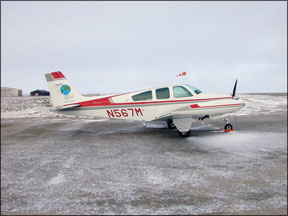
288
organization also hosts an annual convention. Regional associations offer various fly-in and social events.
Owner Comments
I have owned my 1962 Debonair since 1989. Since then I have flown her over 2000 hours. I use her each week to commute between Northern and Southern California, about 300 hours per year, in all types of weather. She has been a reliable and forgiving aircraft, even surviving a goose strike which destroyed the right wings leading edge on a dark and stormy night (the goose did not fare as well). Its also handled encounters with icing and mountain wave turbulence with aplomb, and brought my passengers and me safely home. I have nothing but accolades for this fine aircraft.
For the first 1500 hours I flew with the original IO-470-K 225-hp engine, and planned on 150 knots. About 600 hours ago I switched to the 260hp IO-470-N when 80 octane became unavailable, and now see 160 KTAS with noticeably increased climb performance. In my opinion, this reliable engine is the perfect match for the Deb and alleviates the frequent plug fouling I experienced using 100LL with the K engine.
I make certain all significant issues are dealt with at annual time, which allows for an almost trouble-free aircraft throughout the year. Perhaps it is the frequent flying and 25-hour oil changes, but after 600 hours on the Continental factory re-man upgrade, I barely burn a quart of oil before changing it. Annuals run from $3000 to as much as $8000, including the repetitive wing and empennage inspections, but I tend to opt for getting items replaced or fixed before they break. Fuel burn is 13-14 gph at full power, 2400 rpm, and down to 11-12 gph above 10,000 feet.
For many years I flew IFR without an autopilot, and because of the Debs light control forces, it took a good deal of attention to the gauges to hold altitude and heading. I now fly with an STEC-30 autopilot with altitude hold and GPS steering, which makes my 430 nm commute a breeze, particularly while enjoying XM radio through the Garmin 496.
My Debonair is a fantastic aircraft with more than 6000 hours on it, but it keeps going and going, safely and economically. Although I often consider moving up to a more modern aircraft, I cannot justify the significant cost compared with the relatively minor performance benefits the new breed offer. Thus, I will probably keep my Deb until she decides its time to quit flying.
Charles M. Finkel
Anderson, California
I’ve owned my 1966 C33A Debbonair, equipped with an IO-520-BA at the factory, for almost 10 years and cant imagine another airplane doing so many things so well. I can count on at least 165 KTAS in cruise at most altitudes on between 12.5 and 13.5 gph. Over the time I’ve had it, annual inspections never ranged above $3000 unless we chose to tackle a lingering mechanical or cosmetic issue, or perform blanket parts replacements with a “better safe than sorry” strategy. Most components can be overhauled rather than replaced. I have put 1800 hours on the airplane over 10 years, and have overhauled the engine, redone the interior and had it repainted.
One major mod I made to the airplane-adding tip tanks-has paid for itself in many ways. For one, I can tanker cheap fuel, often avoiding a fuel stop. With only moderate restraint on power settings, I can count on a solid eight hours of endurance, way more than my bladder allows. When fuel is in the tips, the airplanes CG moves forward, alleviating a common problem with the short-bodied Bonanzas and Debonairs. The tip tanks also gave me a gross weight increase, making the airplane a “real” four-seater with five-hour legs. I can easily cover 600 nm or more in four hours. Handling is a dream for most operations, although I always use the autopilot for IFR and long cross-countries. Despite its weight and speed, its a very easy airplane to land, unless the CG has crept aft as fuel burns off. Short- and soft-field operations are very predictable, too.
The cabin is roomy and I’ve never had a passenger complain about feeling cramped. Some do complain about having to climb up on the wing to enter the cabin (I removed the fixed step) but others would complain about getting into a Cessna. It can be drafty in the winter, though, as the aft cabin bulkhead is difficult to seal and all that cold air in the tailcone wants to flow forward into the rear seats. Heating is adequate for the front seats, but less than ideal for the rear. If rear-seat passengers are going to be carried in winter, take along a blanket or two.
Other than fuel and maintenance, my biggest expense has been insurance, which has been averaging around $2400 a year for a smooth $1 million in liability coverage and $140,000 in hull value. This year, though, the same coverage dropped to around $2150, so I’m not complaining. (For reference, I’m a commercial, instrument-rated pilot with about 2500 hours total time and plenty of retract time.)
Would I like something larger and faster? Sure. But it does so many things so well, I cant think of another affordable (for me) airframe that could replace it.
Mike Stevens
Via e-mail
Our family has owned a 1989 F-33A since September 2006. After looking on and off for a fast single for a few years, we bought our Bonanza on the heels of a particularly bad airline trip with our two kids, resolving not to fly on the airlines as a family again. We have not done so since. We have taken the Bonanza to California twice, Florida three times, Colorado, Kentucky and Alabama. We also use the Bonanza routinely for family and business trips around Texas. For a family of four (kids currently 8 and 4) and a travelling dog, it is an ideal mode of transportation.
We purposely bought a Bonanza that post-dates the Beech spar AD. When we bought ours, it already had DShannons IO-550-B conversion. This is a great engine and airframe combination and routinely gives us true airspeeds in the 170s or better. We have added a dual yoke, JPI EDM700 engine monitor and recently recovered the seats.
Maintenance at a well respected local shop is reasonable. We have replaced two starter adapters and a tachometer.
Drew Coats
The Woodlands, Texas

